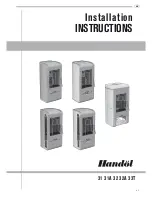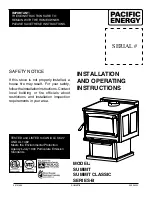
14
© 2021 United States Stove Company
BLOWER OPERATION
The variable-speed blower circulates air warmed by the
firebox into the living area to distribute the heat more
evenly. The blower control knob is located on the side of
the blower housing. Turn the knob clockwise to turn the
blower on. The speed is controlled by turning the knob
clockwise for slower speeds and counter-clockwise
for faster speeds. To turn the blower off, turn the speed
control knob fully counter-clockwise. It is recommended
to turn the blower off when the unit is not in operation. The
blower should be removed at the beginning of every “burn”
season and air-blown clean, removing any dust or build-up.
OPERATION INSTRUCTIONS
CHIMNEY MAINTENANCE
CAUTION:
DO NOT OVERFIRE APPLIANCE. YOU ARE OVERFIRING
IF ANY PART OF THE APPLIANCE GLOWS RED. CLOSE
THE DOOR AND SHUT DAMPER IMMEDIATELY TO
REDUCE THE AIR SUPPLY AND SLOW DOWN THE FIRE.
CAUTION:
SLOW BURNING FIRES FOR EXTENDED USE OR
BURNING GREEN WOOD MAY CAUSE EXCESSIVE
CREOSOTE BUILD-UP. IGNITION OF CREOSOTE
OR OVERFIRING COULD CAUSE A CHIMNEY FIRE.
CHIMNEY FIRES BURN EXTREMELY HOT AND MAY
IGNITE SURROUNDING COMBUSTIBLE MATERIALS.
IN CASE OF A CHIMNEY FIRE, CALL THE FIRE
DEPARTMENT IMMEDIATELY!
CREOSOTE FORMATION AND NEED FOR
REMOVAL
When wood is burned slowly, it produces tar and other
organic vapors, which combine with expelled moisture
to form creosote. The creosote vapors condense in the
relatively cool chimney flue of a slow-burning fire. As a
result, creosote residue accumulates on the flue lining.
When ignited this creosote makes an extremely high
temper fire. The chimney connector and chimney should
be inspected at least once every two months during the
heating season to determine if a creosote build-up has
occurred. If creosote has accumulated (3 mm or more),
it should be removed to reduce the risk of a chimney fire.
We strongly recommend that you install a magnetic
thermometer on your smoke exhaust pipe, approximately
18” above the stove. This thermometer will indicate the
temperature of your gas exhaust fumes within the smoke
exhaust system. The ideal temperature for these gases
is somewhere between 275°F and 500°F. Below these
temperatures, the build-up of creosote is promoted. Above
500°F, heat is wasted since a too large quantity is lost into
the atmosphere.
TO PREVENT CREOSOTE BUILD UP
• Always burn dry wood. This allows clean burns and
higher chimney temperatures, therefore less creosote
deposit.
• Leave the air control fully open for about 5 min. every
time you reload the stove to bring it back to proper
operating temperatures. The secondary combustion can
only take place if the firebox is hot enough.
• Always check for creosote deposit once every two
months and have your chimney cleaned at least once
a year.
•
If a chimney or creosote fire occurs, close all dampers
immediately. Wait for the fire to go out and the heater
to cool, then inspect the chimney for damage. If no
damage results, perform a chimney cleaning to ensure
no more creosote deposits is remaining in the chimney.
CAUTION:
A CHIMNEY FIRE MAY CAUSE IGNITION OF WALL
STUDS OR RAFTERS WHICH WERE ASSUMED TO
BE A SAFE DISTANCE AWAY FROM THE CHIMNEY.
IF A CHIMNEY FIRE OCCURS, HAVE YOUR CHIMNEY
INSPECTED BY A QUALIFIED EXPERT BEFORE USING
AGAIN.
ASH REMOVAL & DISPOSAL
Whenever ashes get 3 to 4 inches deep in your firebox or
ash pan, and when the fire has burned down and cooled,
remove excess ashes. Leave an ash bed approximately
1 inch deep on the firebox bottom to help maintain a hot
charcoal bed. Ashes should be placed in a metal container
with a tight-fitting lid. The closed container of ashes should
be placed on a non-combustible floor or the ground, away
from all combustible materials, pending final disposal.
The ashes should be retained in the closed container until
all cinders have thoroughly cooled.
NEVER OPERATE THIS PRODUCT WHILE UNATTENDED















































